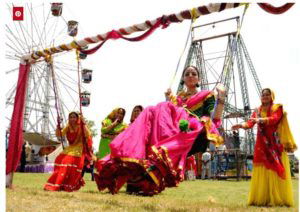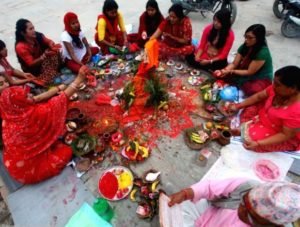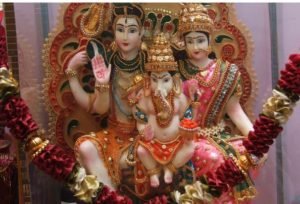Teej : “Festival Which Signifies Love and Devotion of Hindu Women Towards Their Husband”


India is a land of vast diversities, interesting cultures, numerous festivals, and rich traditions. These festivals and traditions are celebrated from time immemorable and their references are often found in many Hindu scriptures.
Among lots of Indian festivals, the festival of Teej is one of the most sacred Hindu festivals and is of great importance to Hindu Indian Women. It is observed in different parts of the country to seek blessings for their husband’s long life.
The Teej festival is celebrated every year in the month of July-August. Married and unmarried women celebrate this festival by praying and observing Teej vrata or fasting. Teej is similar to another popular traditional festival – “Karva Chauth”.

Like all Hindu festivals, the Teej festival too has a scriptural story that why it’s celebrated. The story of Teej is that the word “Hartalika” comes from “Harat”, which means abduction, and ‘Aalika’ which means female friend.
According to a spiritual legend, Goddess Parvati performed severe austerity along the banks of the river Ganga. She did this in order to have Lord Shiva as her husband. However, being an ascetic, Lord Shiva did not know about her.
Her father, King Himalaya, was concerned about seeing her in this condition. So, at the suggestion of Maharishi Narad, he promised her hand in marriage to Lord Vishnu. Goddess Parvati told her friend about this who then decided to abduct her in order to save her from this marriage.
Goddess Parvati was taken to a thick forest where she performed penance and immersed herself in the adoration of Lord Shiva for many years.
Finally, Lord Shiva took notice of her devotion. Lord appeared before her in his divine form and agreed to marry her.
From that moment onwards, Goddess Parvati has been worshipped as “Hartalika” so, Hartalika Teej is observed in memory of her devotion and penance.
Thus, the pious festival of Teej honors the devotion of Goddess Parvati who underwent penance for years to become the consort of Lord Shiva. Women seek her blessings for a happy married life and unmarried girls fast to attain an exemplary husband like Shiva.

There are three types of Teej celebrated in India. These are
The “Hariyali Teej” also known as “Chhoti Teej” is observed on the third day of the bright half of the Shraavana’s Lunar month. It is also referred to as “Singhara Teej”. The meaning of “Hariyali” is “Greenery”. It is believed that the earth will get wrapped in greenery after the summer season. Hariyali Teej is predominantly celebrated in the states of Haryana, Punjab, Rajasthan, Madhya Pradesh, and Maharashtra and also in some parts of Bihar. The greenery during the Shravan month forms the perfect setting for performing traditional songs and dancing during Hariyali Teej.
The Hariyali Teej of Vrindavan is known for its festive air, as Lord Krishna and his disciple Radha’s idols are specially decorated and the golden swing is displayed which attracts visitors from all over the world.
Hindu women offer prayers to goddess Parvati and after the prayers, they sing the folk songs of marital bliss. In many places, grand fairs are also organized.
The Kajari Teej also called “Badi Teej” is held after fifteen days of Hariyali Teej. It is celebrated on the third day of Krishna Paksha (dark fortnight) of the Hindu month of Bhadrapada.
Kajari Teej gets its name from the blackish hue of clouds that signal the onset of rains. It is celebrated in the Southern and Northern parts of the country. The festival is observed in Rajasthan, Uttar Pradesh, Gujarat, Bihar, and Madhya Pradesh, especially in the cities of Varanasi and Mirzapur. People celebrate the festival in order to welcome the monsoon.
Bundi, a city in Rajasthan, is most popular for this Teej festival. The city is beautifully decorated to celebrate the festival. The processions of Teej Mata are taken on the streets of Bundi.
The third type of Teej, “Hartalika Teej” falls in the Hindu month of “Badoo” and is celebrated almost a month after Haryali Teej.
Hartalika Teej takes its name from the name ‘Hartalika’ by which “Goddess Parvati” is known. It is celebrated mainly in the Northern and western parts of India, especially in the states of Madhya Pradesh, Chhattisgarh, Bihar, Jharkhand, and Rajasthan, and in some parts of Maharashtra.

On the occasion of Teej, married and unmarried women observe fast for a peaceful married life and for a loving husband respectively. Some women even observe Nirjala Vrata (fasting without water).
As a tradition, while Hindu women celebrate “Haryali Teej” and “Kajari Teej” by visiting their parent’s houses, they come back to their in-laws for the Hartalika Teej celebration.
Women wake up early in the morning on the day of Hartalika Teej. They wear new clothes, adorn the best jewelry, and apply Heena (mehndi) on their arms and feet. They receive various gifts from their parents and in-laws.
As per the Hindu traditions, it is believed that by wearing all the 16 adornments a woman can keep her husband protected from all evils. This custom of gifting “Sindhara” is particularly significant for the newlyweds
Women worship God Shiva and Goddess Parvati. They offer flowers, sweets, and fruits while all the ladies narrate the holy Teej story (Katha) together.
In some parts of India, holy Neem trees are also worshipped by Hindu women who gather in small clutches and perform the pooja under the direction of a Hindu priest.
Not to mention like all festivals, a fast is also observed by women in this festival will also follow a strict fast. They will not eat anything.
Although the customs may differ from state to state, the unifying factor is that Hindu women irrespective of where they live only seek the blessings of marital happiness and the long life of their husband.
 What is the Significance of Teej?
What is the Significance of Teej?Teej is one of the most sacred Hindu festivals observed in India. It is observed in different parts of the country by Hindu women seek blessings for their husband’s long life. Teej honors the devotion of Goddess Parvati who underwent penance for years to become the consort of Lord Shiva. Women seek her blessings for a happy married life and unmarried girls fast to attain an exemplary husband like Shiva.
A variety of regional traditional sweet dishes are made such as “Ghevar”, “Kheerpuri”, “Nnariyal Laddoo”, “Badam Halwa”, “Sheera”, “Gujiya” and “Kajukatli” are prepared during Teej festivals. Friends, Family relish these delicacies when women break their fast in the evening.
WISHING ALL HINDU WOMEN A VERY HAPPY, BLESSED, AND PROSPEROUS TEEJ
DISCLAIMER: The author is solely responsible for the views expressed in this article. The author carries the responsibility for citing and/or licensing of images utilized within the text.
